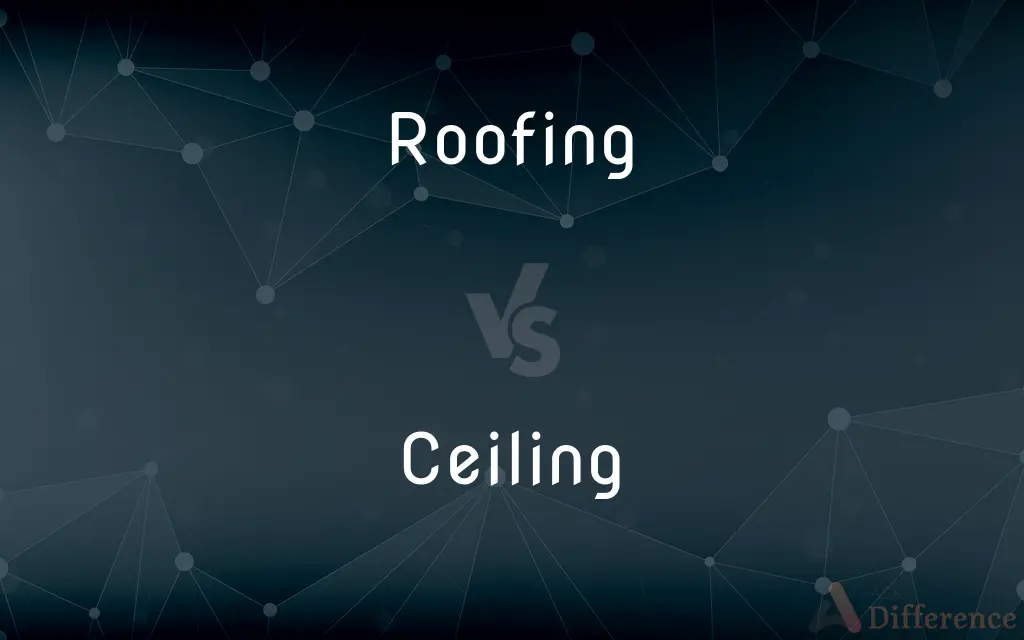Roofing vs. Ceiling — What's the Difference?
By Tayyaba Rehman & Maham Liaqat — Published on February 25, 2024
Roofing refers to the external top covering of a building, protecting against weather, while the ceiling is the interior overhead surface, finishing the space beneath a room or roof.

Difference Between Roofing and Ceiling
Table of Contents
ADVERTISEMENT
Key Differences
Roofing is the external layer of a structure, designed to provide protection from the elements, such as rain, snow, and sun. It involves materials like shingles, tiles, or metal. The ceiling, however, is the internal upper surface of a room, often used to conceal roofing materials or structural elements like joists and beams.
Materials used in roofing are chosen for durability and weather resistance, including options like asphalt shingles, metal, and clay tiles. Ceilings might be constructed from plaster, drywall, or decorative tiles, focusing more on aesthetics and acoustics within a space.
The installation process for roofing involves techniques suited to withstand external conditions, requiring specialized skills and safety measures. Ceiling installation, while also skilled work, is generally less exposed to the hazards of outdoor work and involves interior finishing touches like painting or texturing.
Maintenance for roofing is critical to prevent leaks and extend the lifespan of the roof, involving regular inspections and repairs. Ceiling maintenance is typically less intensive, dealing with issues like cracks, water stains, or cosmetic updates.
The choice between different types of roofing and ceiling materials can significantly impact a building's appearance, energy efficiency, and acoustic properties, highlighting the functional and aesthetic roles each plays in construction and design.
ADVERTISEMENT
Comparison Chart
Location
External top covering of a building
Internal overhead surface of a room
Primary Function
Protection from weather elements
Aesthetic finish, insulation, and acoustics
Materials
Asphalt shingles, metal, clay tiles
Plaster, drywall, decorative panels
Installation
Requires weather-resistant techniques and outdoor work
Involves interior finishing, less exposed to outdoor hazards
Maintenance
Regular inspections for leaks and damage
Primarily cosmetic updates and minor repairs
Compare with Definitions
Roofing
Roofing designs vary from flat to pitched, affecting water drainage.
Pitched roofing is common in snowy regions to prevent snow accumulation.
Ceiling
Ceilings often conceal beams, pipes, and wiring, providing a clean look.
The drop ceiling in the office hid the air conditioning ducts.
Roofing
Roofing is the external protective layer of a building.
The house featured slate roofing for its durability and aesthetic appeal.
Ceiling
Maintenance might involve painting or repairing minor cracks and stains.
The ceiling was repainted to cover water stains from a past leak.
Roofing
It involves materials like shingles and metal for weather resistance.
Metal roofing was chosen for its longevity and low maintenance.
Ceiling
Materials like drywall and plaster are common for ceiling finishes.
The smooth finish of the plaster ceiling complemented the room's decor.
Roofing
Maintenance includes inspecting for damages and ensuring gutters are clear.
Annual roofing inspections help identify potential leak sources.
Ceiling
Acoustic ceiling tiles can improve sound quality in specific spaces.
Acoustic tiles in the home theater minimized echo for better sound.
Roofing
The installation of roofing requires specialized skills and safety measures.
Roofers used harnesses and scaffolds for safe installation.
Ceiling
(architecture) The overhead interior surface that covers the upper limits of a room.
Roofing
The process of constructing a roof or roofs.
Ceiling
The overhead closure of a room.
The dining room had an ornate ceiling.
Roofing
The act of covering with a roof.
Ceiling
The ceiling is the interior surface that covers the upper limits of a room.
The living room had a vaulted ceiling, enhancing its spaciousness.
Common Curiosities
How do vaulted ceilings affect a home's energy usage?
Vaulted ceilings can increase the volume of a room, potentially leading to higher heating and cooling costs, but proper insulation can mitigate these effects.
Can roofing materials be used for ceilings?
While uncommon, some design approaches might incorporate roofing materials like wood or metal for aesthetic or structural reasons in ceilings.
How does the slope of a roof affect its performance?
The slope (or pitch) of a roof impacts water drainage, snow shedding, and can affect the aesthetic appearance of a building.
Are there special considerations for roofing in extreme climates?
Yes, in areas prone to heavy snow, high winds, or extreme sun, selecting appropriate roofing materials and installation techniques is crucial for durability.
How often should roofing be inspected?
It's recommended to inspect roofing at least once a year or after severe weather events to identify and repair any damages.
Are there energy-efficient options for roofing and ceilings?
Yes, reflective roofing materials and insulation products for ceilings can enhance a building's energy efficiency.
Can ceiling designs impact a room's lighting?
Yes, ceiling designs and finishes can influence light distribution and ambiance in a room, with features like recessed lighting or reflective surfaces.
What's the difference between a dropped ceiling and a traditional ceiling?
A dropped (or suspended) ceiling is a secondary ceiling below the main structural ceiling, often used to conceal wiring, piping, or to improve acoustics.
Can I install a new ceiling without replacing the roof?
Yes, ceilings can be replaced or renovated independently of the roof, depending on the interior design needs and structural integrity.
What are "green" roofs and ceilings?
Green roofs are covered with vegetation for sustainability benefits, while green ceilings might refer to eco-friendly materials or designs that reduce environmental impact.
Share Your Discovery

Previous Comparison
Ritalin vs. Dexamphetamine
Next Comparison
Adrenergic Receptors vs. Cholinergic ReceptorsAuthor Spotlight
Written by
Tayyaba RehmanTayyaba Rehman is a distinguished writer, currently serving as a primary contributor to askdifference.com. As a researcher in semantics and etymology, Tayyaba's passion for the complexity of languages and their distinctions has found a perfect home on the platform. Tayyaba delves into the intricacies of language, distinguishing between commonly confused words and phrases, thereby providing clarity for readers worldwide.
Co-written by
Maham Liaqat















































